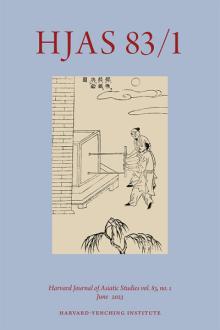June 2023
Shō o tokashi gin to namari zu 鎔礁結銀與鉛圖, in “Gokin” 五金, in Sō Ōsei [Song Yingxing] 宋應星, Tenkō kaibutsu 天工開物, ed. Eda Masuhide 江田益 英, 18 kan 卷 in 3 sec. (maki 卷) in 9 vols. (Osaka: Kanseidō, 1771), v. 7, sec. 3 (ge 下), m. 14, pp. 8b–9a.
Editorial Preface
Articles
Overlooked Silver
Reassessing Ming–Qing Silver Supplies
Numerous silver mines in the southwestern borderlands of Ming and Qing China (present-day Yunnan Province, Myanmar, and Vietnam) are known from occasional historical mention. Despite some regional attention, they were regarded as a marginal source of silver for the Chinese monetary system. This article presents a new research approach that overcomes the scarcity of written sources by tapping mineralogical material remains on historic mining sites. We present case studies of three well-documented sites and discuss our comparative assessment of forty-seven identified mines of importance. Our reconstruction of total silver outputs based on slag dumps permits quantification based on material evidence. We estimate southwestern mines’ outputs at 20,000 to 50,000 tons of monetary-grade silver for the period 1400–1850. Domestic silver flows on this order revise the current view that the monetary system of early modern China depended on overseas silver.
本文根據古爐渣遺存開拓了技術史的方法 , 重新研究了明清時期中國西 南 、 緬甸和越南邊境地區的白銀生產 , 結果發現這一區域的產量至少為 20,000 噸 ⸺ 甚至可達 50,000 噸 , 超過同期海外白銀輸入的數量 , 從而修正了中國傳統市場體系 的發展依賴於海外白銀輸入的認識 。
Daoist Primers and Identity, 1340–1900
Since the Yuan period, Daoists have often presented their religion to adepts and outsiders in catechisms—concise introductions to the history of Daoism, its main gods, and its ideology. I focus on one type of catechism, a family of texts often entitled “Daojiao yuanliu” (Origins and development of Daoism). I trace the history, from the late Mongol period through the Qing, of various editions that were included in hagiographies and novels as well as in more highbrow encyclopedias and manuscript booklets. I show that these texts developed a specific theology and asserted a strong confessional identity, sometimes in tension with Buddhism, that reminded readers of the Mongol-era debates that resulted in the burning of the Daoist Canon in 1281. This discourse is markedly different from the more accommodating vision of Daoism found in most late imperial elite discourses.
元代以來,道士們經常以稱為”道教源流”的文本向弟子與平民介紹道教的歴史、神靈以及教義。本文介紹了收錄在神傳、小說、類書及手抄本中的幾種不同版本的”道教源流”及其歴史。這些文本都主張一種特定的神學與道教身份,並提及元代的佛道辯論,以及 1281 年的《道藏》焚毀。
Scented Protection
Saffron’s Transcultural Premodern History
Propelled by the flourishing Silk Road, a wide range of aromatics entered the Sinitic world from India, Southeast Asia, and Persia in the first millennium CE. This article offers a cultural biography of saffron (yujin xiang), a plant of Kashmiri and Persian origins that was imported into the Sinitic world starting in the fifth century. By studying a nexus of medical writers, Buddhist monks, traders, and envoys who participated in the circulation and deployment of saffron, I explore the process of knowledge-making that endowed the aromatic with assorted uses in Tang society. To understand and utilize the fragrant substance, Chinese actors regularly aligned it with preconceived notions in their own cultural repertoire. I argue that the transmission of saffron and its associated knowledge across cultural spheres was a dynamic process of negotiation between the novel and the classical, the foreign and the domestic, the exotic and the familiar.
本文呈現了絲綢之路上鬱金香的跨文化史。這種來源於克什米爾和波斯地區的名貴香料在唐代社會被賦予多種用途。通過探討醫者、僧侶、商人和使節如何傳播、理解和使用鬱金香,本文展示了與此香料相關的新知識是在域外與本土文化的不斷互動中產生的。
